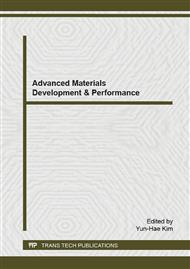p.23
p.27
p.32
p.36
p.40
p.44
p.51
p.56
p.60
Fabrication and Performance Evaluation of Cellulose Nanofiber/PVA Composite Films
Abstract:
The mechanical strength of cellulose nanofiber-reinforced polyvinyl alcohol (PVA) composite films was evaluated by means of tensile test to explore the effect of fiber content and processing condition to the mechanical strength. Cellulose nanofibers were mixed with PVA resin at different weight ratios of 10, 20, 30, 40, 50, 60, 70, 80 and 90wt% and tensile tests were done on the composite films with thickness of 0.08~0.11mm. A set of samples for every respective weight ratio was hot-pressed at 180°C and 10MPa pressure and tensile tests were conducted to compare the failure behavior of the hot-pressed and the non hot-pressed composite films. The results showed that hot-pressed composite films exhibit a linear stress-strain curve as compared to the non-hot pressed composite films, which exhibited more ductile characteristic. For non hot-pressed specimens, tensile strength showed almost no significant increase from 0wt% to 50wt%, and finally a sudden increase especially from 50wt% to 70wt% fiber content where the highest average value recorded was 149MPa at 70wt%. As for hot-pressed composite films, the highest value of 167MPa at 60wt% was obtained without significant pattern of reinforcement effect with the change of nanofiber content. The reinforcement effect derived from cellulose nanofiber has shown favorable results which indicated an increase in the composite tensile strength of about 33.3% from pure PVA specimen, and hot-press process, though has reduced the ductile characteristics of the composite films, has increased tensile strength of the specimens up to 22% as compared to pure PVA specimens.
Info:
Periodical:
Pages:
40-43
Citation:
Online since:
June 2015
Keywords:
Price:
Сopyright:
© 2015 Trans Tech Publications Ltd. All Rights Reserved
Share:
Citation:


